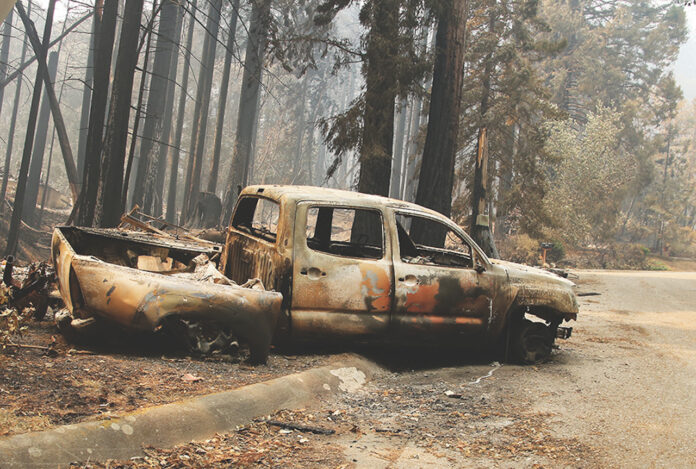The Cal Fire San Mateo-Santa Cruz Unit (CZU) had a plan of how to handle the lightning strikes that eventually set off one of the most destructive fires in the history of the state: the now-infamous CZU August Lightning Complex.
“We followed the plan to a T,” Cal Fire CZU Deputy Chief Nate Armstrong said in a virtual town hall Tuesday. “It was well implemented, it was well exercised, unfortunately, we just didn’t have the resources to fully staff all the fires like we would’ve wished.”
Cal Fire CZU officials this week held a series of webinars discussing what they had learned from the CZU Complex, which charred 86,509 acres in the Santa Cruz Mountains and destroyed 1,490 structures, including nearly 1,000 homes. Among the unit’s key takeaways: droughts and climate change might change its “fuel” conditions standards and its reduction efforts.
“We have been noted here on the Central Coast as being the asbestos forest—fires just don’t burn here because of our mild climate and the high fuel moistures because of the great rain seasons that we have here,” Cal Fire CZU Chief Ian Larkin said. “But we haven’t experienced that in many, many years. It’s really having an effect in how we’re going to look at fuels going forward.”
That could include stepping up its reduction efforts, which Larkin admitted has been a task that is “very difficult to achieve.” Larkin said that would require cooperation from the county’s resource conservation and fire safety districts. Cal Fire CZU would also need to find funding to undergo those efforts.
The fire left a $68 million bill in its wake. Those funds were expended fighting the blaze, which claimed one life and forced the evacuation of tens of thousands of Santa Cruz County residents. Along with activating all firefighters in the local unit, Cal Fire also brought in several county fire units into the weeks-long battle. Still, Armstrong said, it wasn’t enough. Cal Fire CZU was so overwhelmed by the quintet of fires that exploded to more than 80 acres over the first 24 hours that some firefighters who started their day at 3am on Aug. 16 were still at the front lines more than a day later.
“It got down to the extent where we had folks in pickup trucks with hand tools to just be able to get people out and find these fires and assess what we had,” Armstrong said.
Cal Fire’s resources, Larkin said, were strained because the CZU Complex was not the lone large fire burning last summer. At least 585 fires broke out across California from the same lightning storm, including the SCU Lightning Complex that engulfed nearly 400,000 acres in neighboring Santa Clara County and nearby Alameda, Contra Costa, San Joaquin, Merced and Stanislaus counties.
It wasn’t until five days after the fire had ignited that the total number of personnel under CZU’s command eclipsed 1,000. That included National Guard troops, local and state agencies and firefighters from out of the state. It also had access to seven helicopters, 26 water tenders and 30 fire engines. But by then, the fire had grown from 861 acres to more than 76,000.
“It’s a constant thing that we’ve heard, is that we didn’t have enough [resources] on this fire, and what you’re hearing from us tonight is that we absolutely agree,” Armstrong said. “Chief Larkin and I agree wholeheartedly that we did not have enough resources, pretty much, of any type on this fire. We knew that from the beginning. We were constantly trying to get additional resources in.”
Larkin said that in the future, evacuations might have to move faster during major fire events because of the narrow terrain in the Santa Cruz Mountains that made it difficult for mass quantities of residents to leave the area. He also had concerns that not enough people had tapped into the county’s “Code Red” system, which sends safety alerts directly to residents’ phones. Cal Fire could also, Larkin said, try to increase its fire prevention messaging and policing in the coming years.
“When fire season is coming [we need to teach people] how to prepare for that and what things to be ready for,” he said. “We’re looking at methods of how to increase that messaging and serve the public under that format.”









